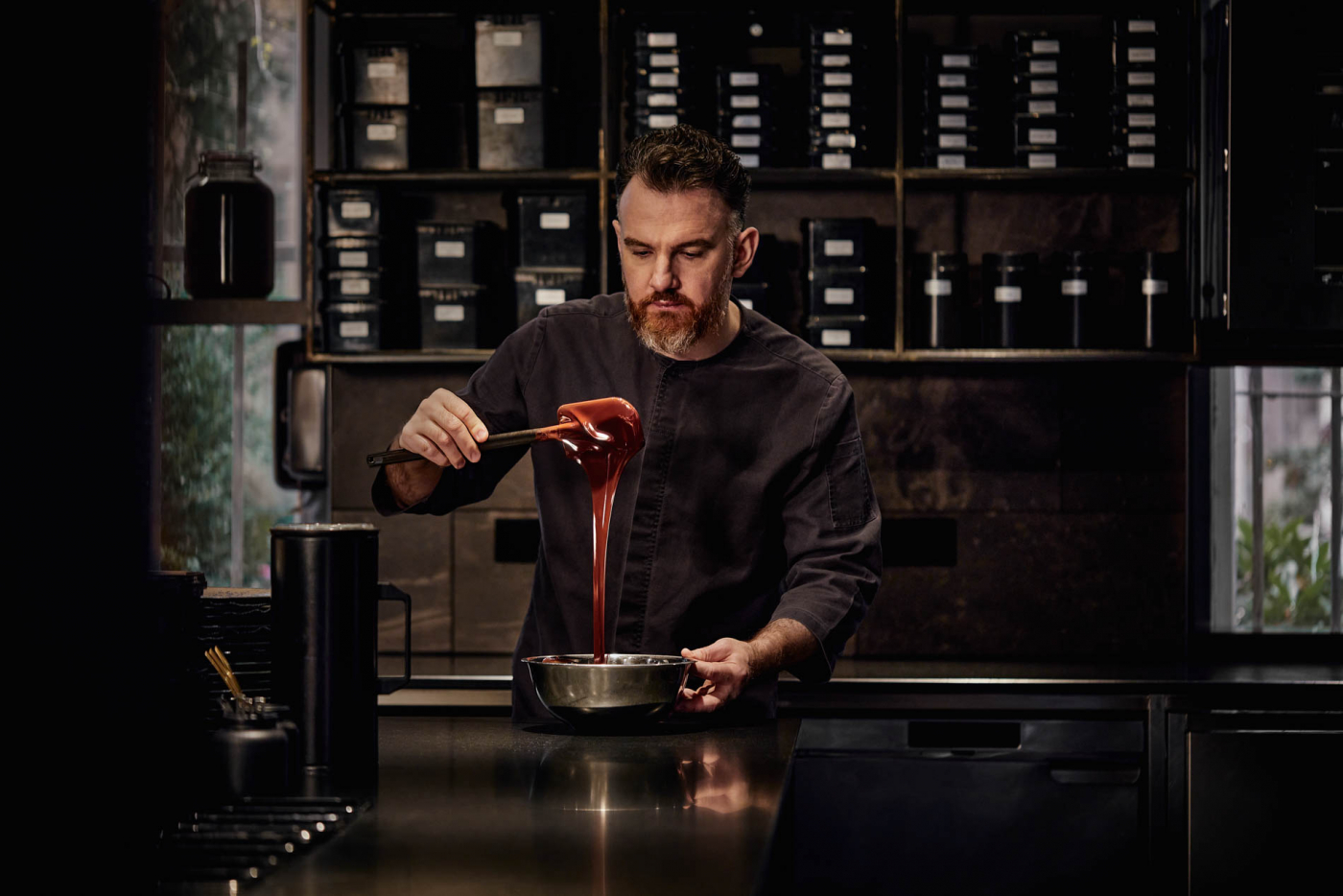
The proof in the puddings | CODA Dessert Dining, Berlin
David J Constable bites into chef René Frank’s dessert landscape in Berlin

David J Constable bites into chef René Frank’s dessert landscape in Berlin

Enough already. Stop it with these lists. They mean nothing and have become ubiquitous and reductively ridiculous. Sure, they make chefs and their PRs happy, presenting them with an excuse to make shrines of their windows from an assortment of plates, plaques and stickers, but when has following the so-called wisdom of the crowd ever resulted in anything good?
Michelin long stood at the top of the totem for inquisitive restaurant analysis, but their influence appears to have waned. The little red book slipping into an ever more smug Francophile flirtation with a growing financial eye on Asia. Some kneel at the feet of The World’s 50 Best Restaurants organisation, which rather than reward and hand out stars, crowns one winner each year, pitting chef against chef. In the eyes of some, they have already replaced Michelin.
Who would be a chef today? I mean, who are they catering for?
There is also The Best Chef Awards, which is the latest so-called authority to enter the kitchen grappling pit and TripAdvisor, of course, populated by spotty keyboard perverts late at night (and by the mums of chefs). And then there’s OAD Top Restaurants and Elite Traveler’s Readers’ Choice Awards and the AA Guide, Zagat, Good Food Guide, Harden’s, Time Out’s 50 Best-in-whichever-city catalogue and those peculiar BuzzFeed odd-numbered listicles. Plus Egon Ronay, if that’s still a thing? And all the newspapers, magazines and blogs, with their supposed wisdom from the maturity of a woke, vegetarian intern.

Concentrated carrot and aerated yoghurt, crispy buckwheat, ginger confit and finger-lime
Who would be a chef today? I mean, who are they catering for? Are they feeding hungry families, cooking celebrated and innovative food, or are they creating an experience? Are they working towards a star or wanting to break into a list, a round-up, or a run-through of the region’s must-tries? Or to make the Top 10, the Best 50, or another 101 Places to Try Before You Die listicle? And what about the many guest variances and disorders? The meat-free, plant-based, no-sugar, heaving in-the-bathroom bulimic lacto lunes. How do they pivot their kitchen and prepare for them? Who would be a chef?
René Frank and CODA Dessert Dining in Berlin offers something different. Yeah, yeah, you have probably heard this shtick before. And with a name like that, they’d have to be thinking outside the box; coda meaning the conclusion of something. It is also “tail” in Italian. That last part of the restaurant’s designation, so evidently promotes the sugary expectation of puddings and post-meal sweeties, doesn’t it? Why? Because that’s how we’ve been programmed. When we hear ’dessert’ we think of sugary treats and pastry delights. Those last-mouthful end-of-meal goodies.

CODA, by Claudia Goedke
CODA, however, isn’t a rejection of the pseudo snobbery of fine dining, but a diversion from the traditional, tiresome, rolled-out understanding of a savoury-sweet tasting menu. You know the type, the structured, authentic flow of Escoffier’s legacy. A meal begins with something soupy and moves towards a fishy tale before diving into protein and finishing with some sickly confectionery. It is the old Michelin-star fallacy, rewarding guests with an international menu of three or four courses, plus petit fours, and then over-charging them for the privilege. But how outdated in this age of parameter-stretching experiences, as diners seek the extraordinary over the ordinary, and chefs must adapt and be daring.
Cooking well is no longer a sufficient qualification. We live in a time when it is not enough for the guest to simply eat; they must also appease their sweaty-palm arrogance of populating social media in a need to feel relevant. It is a depressing age when Likes mean prizes. And for the chefs, how else do they expect to climb that list, keep that star, or garner feedback from some megalomanic with a vote? Seriously, who would be a chef?
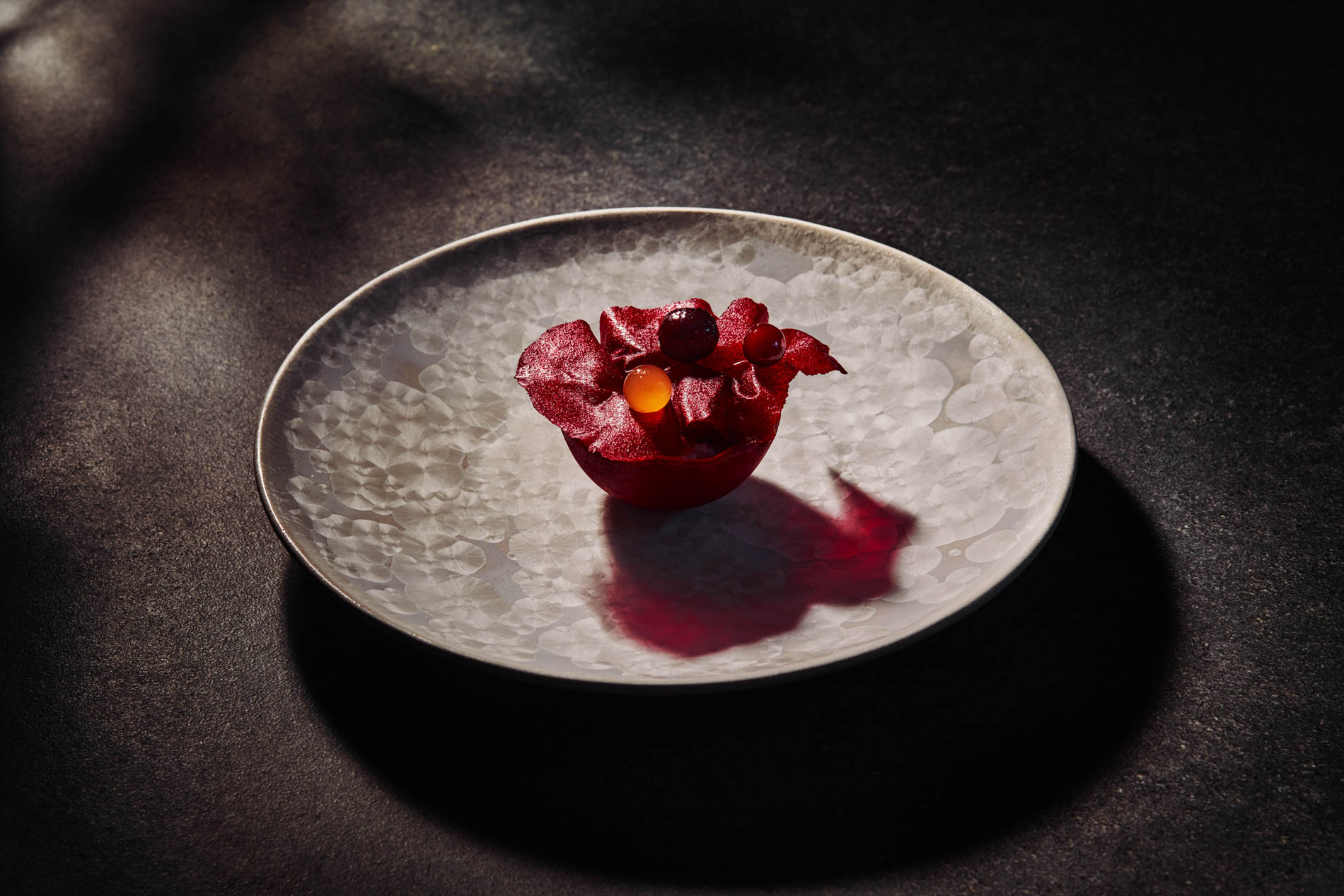
Iced beetroot and tofu mousse, cranberries, honeycake, verjus-jelly
We all seek the creatively obscure. When you’re in Berlin, you don’t want lasagne or fish and chips. You want German stuff like labskans, konigsberger lopes and a late-night scharf döner. What you want is the experience. As a finer writer than I once noted, restaurants serve customers. They sell them hospitality. It’s the customers’ needs, assumptions and pockets they serve. But the foodie customers these days, with their eyes affixed to their phones as if some whopping revelation is about to be dropped, are serving a dedicated legion of faceless disciples.
It is an explorative, topsy-turvy, rollercoaster of a menu at the zenith of dessert sophistication
If you can find CODA among the graffiti and public artistry of Berlin’s Neukölln spray-can desperados, then you’re in for something different. Something that’ll clog your socials with weird and wonderful expressive plates. This is a 15, possibly 16, course tasting menu at Germany’s first and only two-star dessert restaurant. It is an explorative, topsy-turvy, rollercoaster of a menu at the zenith of dessert sophistication. With René solely and unabashedly focused on the reinterpretation of puddings. In a departure from the standardised savoury-sweet structure of most modern menus, René challenges guests to re-evaluate what they think of as dessert.
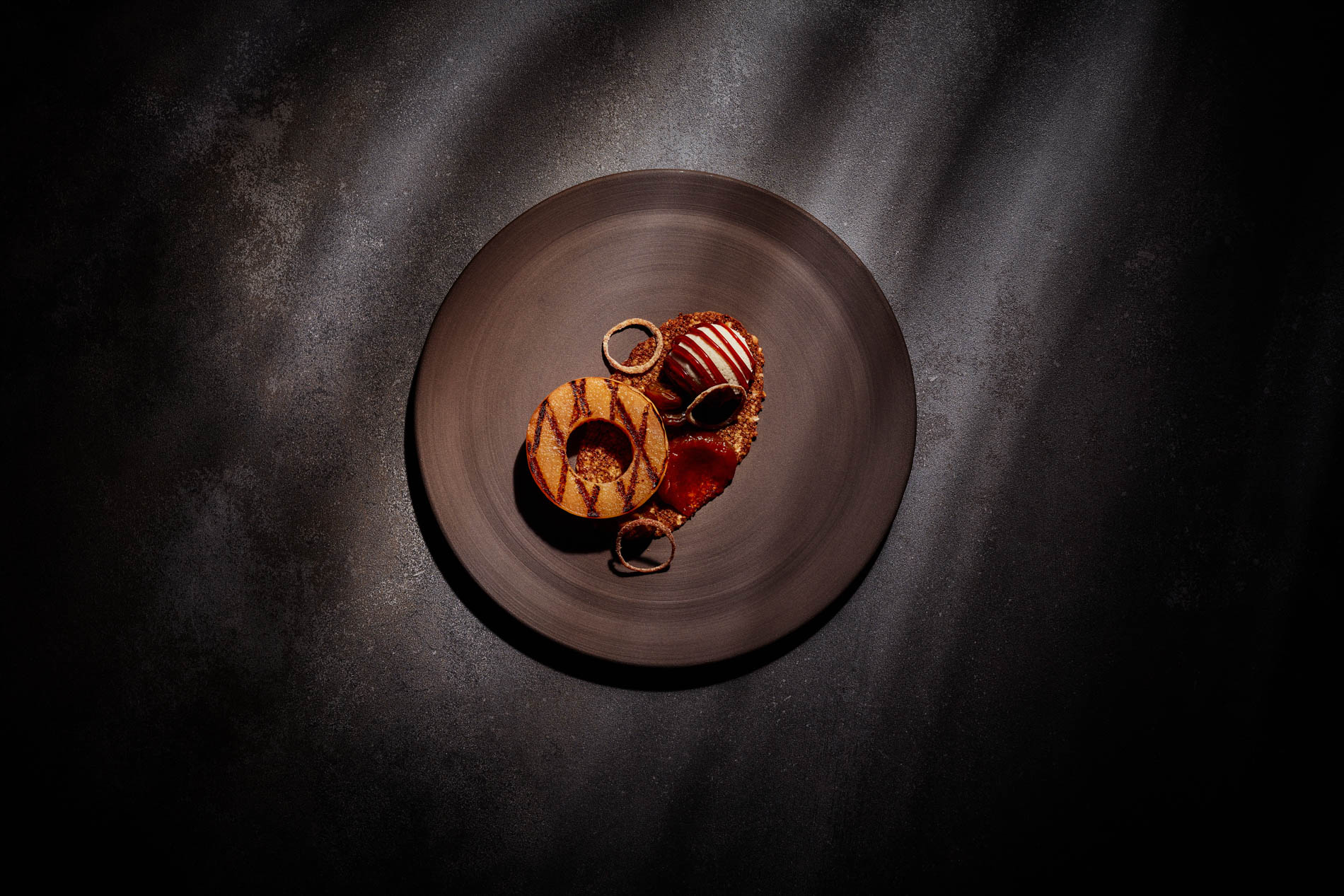
Charcoal grilled apple, fermented oat caramel, sultanas and shallot jam
“You zink of sugar and sweetness, ya, all the fun stuff at vee end of your meal?” René asked me when we met at a bar before my visit to CODA. Although, I think he meant it rhetorically and as a statement because before I could answer, he’d moved on. “Ve’ve got to be open to everything and examine how countries and cultures approach desserts, ya. If you think about France, Japan, Austria or Thailand, then zee all have completely different outlooks. Vee uses a lot of vegetables, but vee treats them like fruits, ya.”
My meal began with three little vegetable treats. A beetroot gummy bear, a “beefcake” with bone marrow and a Gouda-filled brioche doughnut. They decorated the doughnut table-side with a squiggle of turnip caramel, for an umami, truffle-like punch. All three were complex, but not pretentious. All experimental without the use of refined sugar; and all with twists and humorous spins. The gummy bear was great, its natural beetroot tang bouncing here and there and everywhere in a nostalgic nod to children’s 80s television. The beefcake was temptingly soft, made from sweet potato, while the doughnut was supple and gooey from the concealed Gouda. All three had a root-veg theme, although hardly clear in the result. No refined sugars, syrups, bi-carb, colouring, fructose or flavour-enhancers are used, only the natural profile of each ingredient and some clever kitchen manipulation. This included the use of amazake, the sweet rice drink used to ferment miso, soy sauce and sake in Japan and as an alternative to white sugar.
Next up was a yellow tomato with chickpea and lemon. It was another course that allowed the natural sweetness and inherent juices to shine, rather than mask or enhance with outside influence. Eggplant followed with pecan and apple balsamic and finished with a pinch of liquorice salt. This was paired expertly with a glass of César Florido Oloroso. The likes of sherry, brandy, port and sake all find comfortable homes on a menu like this. I’m a few courses in and would describe this as a litany of pure desserts. Not pastries or ice creams or sugary treats, but formed from strange and unexpected savoury combinations.
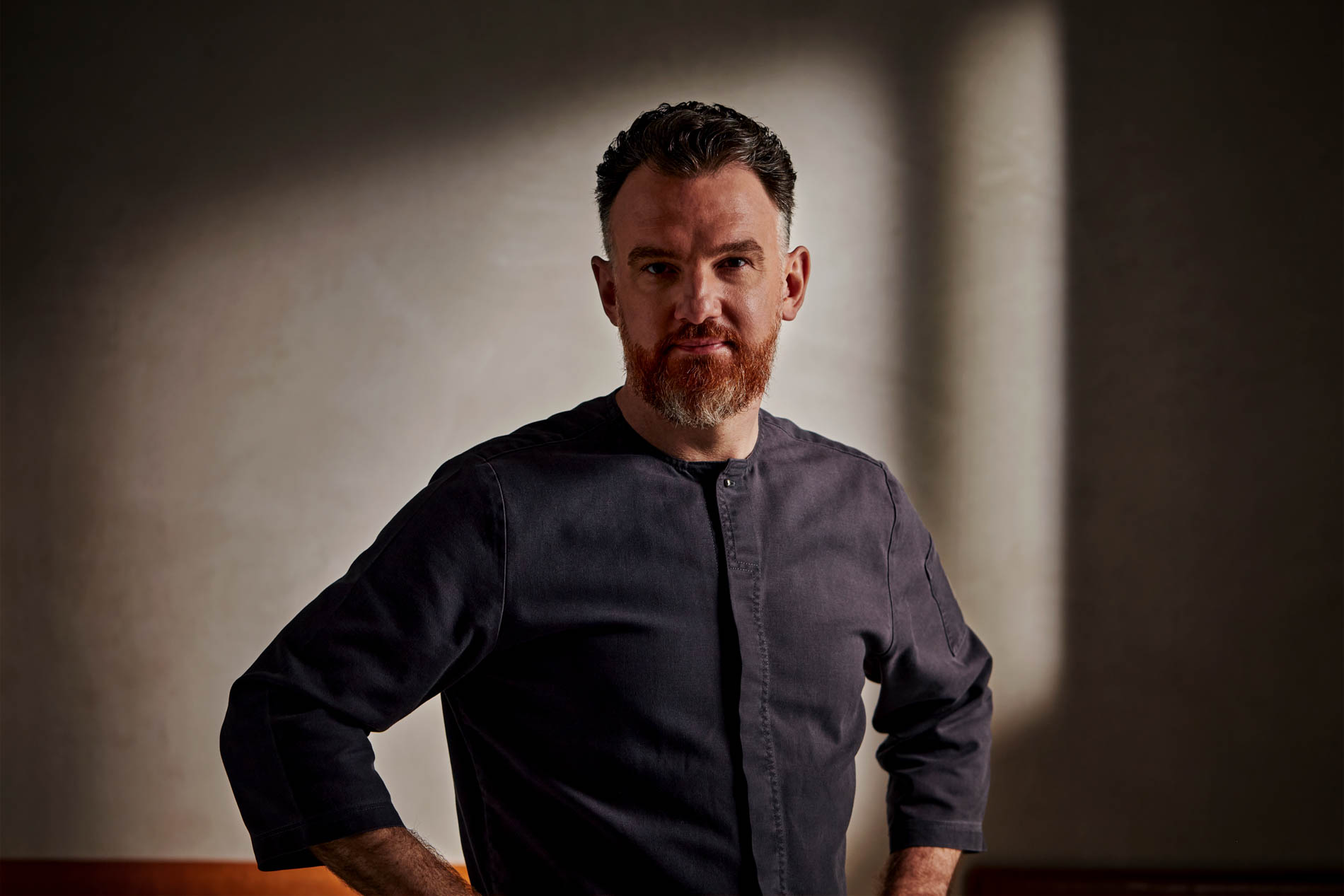
René Frank
And then a waffle I smelt before it had arrived at the table. And what a waffle. Fluffy and buoyant, as all good waffles should be, served fresh from the iron. And concealed within the criss-cross triangle slice, rivers of hot, gooey Swiss raclette. On the side, yoghurt with dehydrated kimchi for an acidic lick. It was a waffle wonder. A waffle stunt of highfalutin praise and giddy adoration. And it was exactly what would happen if a waffle mated with a croque monsieur. In this age of sexual fluidity, who’s to say that you can’t be born a waffle and shift your batter pronoun to a pastry or hot French sandwich? That is what René has created: a very personal, carnal, and a little naughty, epicurean experience. With a waffle.
The caviar popsicle is the restaurant’s signature, and rightly so. Shaped from a combo of vanilla, frozen artichoke and pecans and rolled in 12g of D’Aquitaine Oscietra Caviar, it is a mini beauty, a luxe Magnum rip-off that CODA has made their own. Biting and crackling the casing, a flush of cold ganache ran down my throat. The nuttiness and salty pops endured, lacing my gums. It comes with a €45 price-tag, however, on top of the €244 (Tue-Thur) and €274 (Fri-Sat) cost of the tasting menu. The wine and juice pairings are additional. The popsicle fee, though, is rather good given that it’s a two-star caviar lolly-pop and the lusty emotion it evokes.
The sommelier, Sophia Fenger, was delightful, despite her insistence that I try Riesling. It wouldn’t have been an issue if the famed Rhine grape appeared once or twice as part of the pairing, but across multiple courses, nah. It just isn’t the grape for me. And yet, despite my reluctance, her spirit never faulted. At one point, she engaged me in my favourite wines, returning shortly after with a bottle of Roagna Rosso 2017 from Langhe. Ah, Nebbiolo. Now there’s a classy grape. It was a sleek and impressive move. Terrific service indeed.
And on we go, recipes reimagined from exemplary ingredients, and with exhausting attention to detail. A Cirone cheesecake features celeriac and coffee and is a beautiful assembly. But it’s too intense for me at this late stage of the meal, especially after the ice-cool creaminess of the popsicle. Pork grissini and sauerkraut was a great big slap of salty continuation and another departure from the expectation of sugary-sweet. Italian-inspired, the meaty rather than doughy, grissini dunkers were a surprise. Made from puffed caramelised pork skin and rolled in a sauerkraut powder, they prickled the mouth with salt and fat. The funky lactic fermentation of sauerkraut dabs added a needed cleanliness. It was the sort of Germanic treat I was looking for from such a lauded (and highly listed) restaurant in Deutschland.
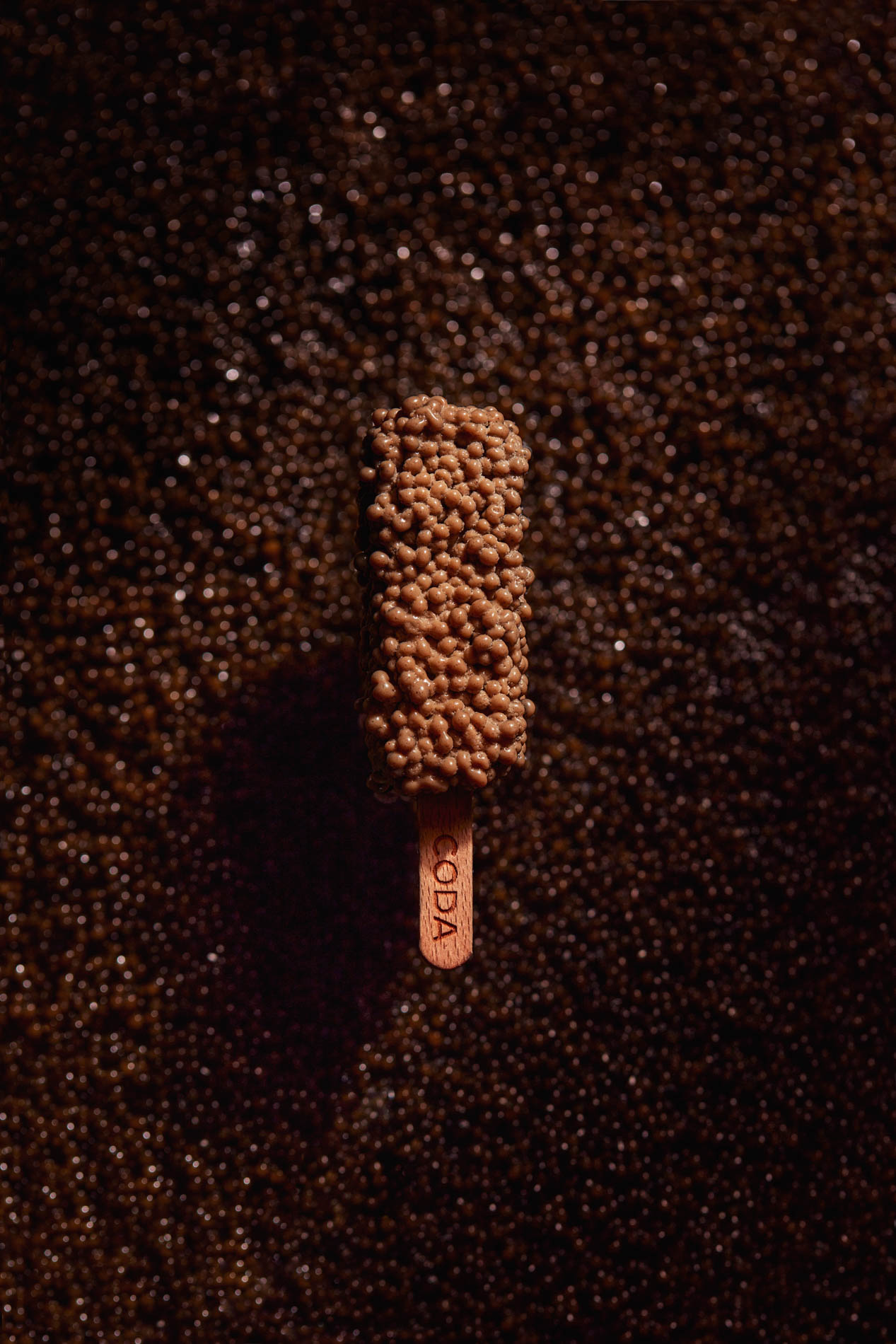
Caviar Popsicle with Ossietra
They then led the table to the kitchen for a tour of the chocolate cooling slabs and mechanical operation with the head chef, Julia Leitner. However, the most noticeable thing was the red Michelin plaque screwed to a wall at the back. Two shiny stars, hidden. “Ah, ya,” remarks René, “Vee put it outside, at vee front of za restaurant, but they [those spray-can desperados] covered it in graffiti, so ve’ve had to move it inside.” How hip. How very Berlin.
And then near the conclusion, they showed us the raw cacao preparation, selected at a specific 76% of components derived from the bean. René calls this “bean to plate”. The result is a choccy cherry bomb with caramelised Teto Tofu and an almond cream made from roasting the cherry pits and infusing it with almond milk. Again, nothing is added, nothing is wasted and nothing is discarded if it can be repurposed. This came with a 10-year Quinta do Infantado port.
Of course, if you are fortunate enough to be included on a list with clout, then that’s great. Well done. Glückwunsch. An industry pat on the head is a byproduct of the work being done. But it is not the reason chefs get into the industry. Or, at least, it shouldn’t be. And while anyone can assemble a list, from the best restaurants in the world to the countries with the perkiest bums, they can influence and play a role. Especially if you’re number one. Everyone loves a winner. But ignore them all and listen to me. CODA is out on that culinary ledge; incomparable to anything else out there in the fine dining universe.
While the menu is long and not every course lands, René is moving meal time into a new dietary direction. He is attempting to take the diner into a new dessert future, proving what someone can achieve once they break away from traditions and the perceived thinking of the global fine dining mentality. Sweet and savoury can be interchangeable. And what is meant by sweet, anyway? And does pudding have to look a certain way? Does dessert mean sugar and cream and pastries and syrup? Better still, shouldn’t we celebrate desserts in which fruits and vegetables, and their natural profile, are shown favouritism? Think about the great British apple crumble or the Indian lauki ka halwa. Isn’t it our narrowmindedness and reluctance to adapt that is holding the evolution of cooking and the progress of desserts back? CODA stamps down on tradition and already has one foot in the future. C
CODA Dessert Dining, Friedelstraße 47, 12047 Berlin, Germany
coda-berlin.com